Tithonian
In the geological timescale, the Tithonian is the latest age of the Late Jurassic epoch or the uppermost stage of the Upper Jurassic series. It spans the time between 152.1 ± 4 Ma and 145.0 ± 4 Ma (million years ago). It is preceded by the Kimmeridgian and followed by the Berriasian stage (part of the Cretaceous).[1]
| Tithonian | |
|---|---|
| 152.1 ± 0.9 – ~145.0 Ma | |
| Chronology | |
Key events in the Jurassic -200 — – -195 — – -190 — – -185 — – -180 — – -175 — – -170 — – -165 — – -160 — – -155 — – -150 — – -145 — – how to approximate the timescale of key Jurassic events. Vertical axis: millions of years ago. | |
| Etymology | |
| Name formality | Formal |
| Usage Information | |
| Celestial body | Earth |
| Regional Usage | Global (ICS) |
| Time scale(s) used | ICS Time Scale |
| Definition | |
| Chronological unit | Age |
| Stratigraphic unit | Stage |
| Time span formality | Formal |
| Lower boundary definition | Not formally defined |
| Lower boundary definition candidates |
|
| Lower boundary GSSP candidate section(s) | |
| Upper boundary definition | Not formally defined |
| Upper boundary definition candidates |
|
| Upper boundary GSSP candidate section(s) | None |
Stratigraphic definitions
The Tithonian was introduced in scientific literature by German stratigrapher Albert Oppel in 1865. The name Tithonian is unusual in geological stage names because it is derived from Greek mythology. Tithonus was the son of Laomedon of Troy and fell in love with Eos, the Greek goddess of dawn. His name was chosen by Albert Oppel for this stratigraphical stage because the Tithonian finds itself hand in hand with the dawn of the Cretaceous.[2]
The base of the Tithonian stage is at the base of the ammonite biozone of Hybonoticeras hybonotum. A global reference profile (a GSSP or golden spike) for the base of the Tithonian had in 2009 not yet been established.
The top of the Tithonian stage (the base of the Berriasian stage and the Cretaceous system) is marked by the first appearance of small globular calpionellids of the species Calpionella alpina, at the base of the Alpina Subzone .
Subdivision
The Tithonian is often subdivided into Lower/Early, Middle and Upper/Late substages or subages. The Late Tithonian is coeval with the Portlandian stage of British stratigraphy.
The Tithonian stage contains seven ammonite biozones in the Tethys domain, from top to base:
- zone of Durangites
- zone of Micracanthoceras micranthum
- zone of Micracanthoceras ponti or Burckardticeras peroni
- zone of Semiformiceras fallauxi
- zone of Semiformiceras semiforme
- zone of Semiformiceras darwini
- zone of Hybonoticeras hybonotum
Lithofacies
In the ocean of Tethys, the Tithonian has a calcareous facies with a typical cephalopod fauna. The Solnhofen limestone of southern Germany, which is known for its fossils (especially Archaeopteryx), is of Tithonian age.
Palaeontology
†Ankylosaurs
| Ankylosauria of the Tithonian | ||||
|---|---|---|---|---|
| Taxa | Presence | Location | Description | Images |
| Morrison Formation, Wyoming, USA | The smallest and the earliest well-known ankylosaur. Its skull measures only 29 cm in length, and its total body length is an estimated three to four meters. |  Gargoyleosaurus skeleton | ||
|
Morrison Formation, Colorado, USA | A poorly known early ankylosaurian. | ||
Theropods
| Theropods of the Tithonian | ||||
|---|---|---|---|---|
| Taxa | Presence | Location | Description | Images |
| USA, Portugal, Tanzania | The most common and most highly studied theropod dinosaur. |  Allosaurus  Archaeopteryx chasing a juvenile Compsognathus.  It is believed that the Port Waikato creature was similar to Compsognathus longipes, shown here.  Lourinhanosaurus  Ostafrikasaurus  Stokesosaurus  Tanycolagreus  Torvosaurus  Veterupristisaurus | ||
| Alte Schöpfel quarry, Schaudiberg, Bavaria | A basal avialan, placed just above Archaeopteryx in the evolutionary tree. | |||
| Solnhofen, Germany | The late Jurassic is notable for the first appearance in the fossil record of birds, in the form of Archaeopteryx, found in limestone quarries in Germany. | |||
| Morrison Formation, USA | Fossils are less common than those of Allosaurus. | |||
| Solnhofen, Germany | Found near Archaeopteryx fossils. | |||
|
Port Waikato, New Zealand | Only known Tithonian dinosaur in New Zealand. | ||
| Jimbo Quarry, Morrison Formation, Wyoming | Hesperornithoides is a genus of basal troodontid theropod dinosaur. | |||
| Kimmeridge Clay Formation | known from a single specimen consisting of an associated partial skeleton represented by a complete pelvis as well as a partially complete leg, and neck, back, and tail vertebrae. | |||
| Lourinhã Formation, Portugal | A genus of medium sized carnivorous theropod dinosaurs. A basal tetanuran, might be an allosauroid, megalosauroid or a coelurosaur. | |||
| Tendaguru Formation, Tanzania | The earliest known spinosaurid. Tooth fossil. | |||
| Morrison Formation, Utah | Stokesosaurus is a genus of small early tyrannosauroid theropods. | |||
| Morrison Formation, Wyoming | Tanycolagreus is a genus of basal coelurosaurian theropod. | |||
|
|
Torvosaurus was a very large megalosaurid predator, with an estimated maximum body length of 10 m (33 ft) and mass of 3.6–4.5 tonnes (4–5 short tons) for both its species, making Torvosaurus among the largest land carnivores of the Jurassic. Thomas Holtz estimated it at 12 meters (39 feet). Claims have been made indicating even larger sizes. | ||
| Tendaguru Formation, Tanzania | The earliest known carcharodontosaurid, possibly sister to Acrocanthosaurus. Estimated to have been about 8.5 m (28 ft)-10 m (33 ft) in length; teeth that may belong to Veterupristisaurus indicate sizes in excess of 12 meters and 6 tonnes.[4] | |||
| Solnhofen, Germany | Wellnhoferia is a genus of early prehistoric bird-like theropod dinosaur closely related to Archaeopteryx, possibly a synonym of Archaeopteryx lithographica. | |||
†Heterodontosaurs
| Heterodontosaurs of the Tithonian | ||||
|---|---|---|---|---|
| Taxa | Presence | Location | Description | Images |
| Fruita, Colorado, USA | Fruitadens was a heterodontosaurid and the smallest known ornithischian dinosaur, weighing less than 2 pounds (0.91 kg) and measuring a little over 2 feet (0.61 m) in length. It is also one of the latest surviving heterodontosaurids known. | 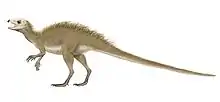 Fruitadens | ||
†Ceratopsians
| Ceratopsia of the Tithonian | ||||
|---|---|---|---|---|
| Taxa | Presence | Location | Description | Images |
| Chaoyang area, Liaoning, China | One of the earliest ceratopsians | 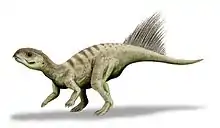 Chaoyangsaurus | ||
| Hebei, China | A member of the family Chaoyangsauridae, it was one of the earliest ceratopsians | |||
†Ornithopods and Basal Neornithischians
| Ornithopoda and basal Neornithischia of the Tithonian | ||||
|---|---|---|---|---|
| Taxa | Presence | Location | Description | Images |
| Kimmeridgian to Tithonian | Wyoming, USA | Camptosaurus could be more than 7.9 meters (26 feet) long, and 2.0 meters (6.6 feet) tall at the hips. They had heavy bodies but, as well as walking on four legs (quadrupedal), could also rear up to walk on two legs (bipedal). This genus is closely related to iguanodontid and hadrosaurid dinosaurs. It probably ate cycads with its beak. |
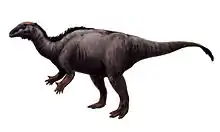 Camptosaurus  Othnielosaurus | |
| Lourinhã, Portugal | A camptosaurid iguanodont | |||
†Plesiosauria
| Plesiosaurs of the Tithonian | ||||
|---|---|---|---|---|
| Taxa | Presence | Location | Description | Images |
|
 Simolestes | |||
†Pterosauria
| Pterosaurs of the Tithonian | ||||
|---|---|---|---|---|
| Taxa | Presence | Location | Description | Images |
|
Solnhofen, Germany | Short head with pin-like teeth, short tail but from a normally long tailed group "Rhamphorhynchoidea" |
 | |
|
Morrison Formation, Wyoming, United States | Known only from an intact fourth metacarpal, 57.5 millimetres long | ||
| Solnhofen, Germany | ||||
|
Solnhofen, Germany | |||
|
Morrison Formation, Wyoming, United States | |||
| Solnhofen, Germany | ||||
|
Solnhofen, Germany | |||
|
Neuquén, Argentina | |||
|
Solnhofen, Germany | |||
|
Solnhofen, Germany | |||
†Stegosaurs
| Stegosaurs of the Tithonian | ||||
|---|---|---|---|---|
| Taxa | Presence | Location | Description | Images |
| Kimmeridgian to Early Tithonian | Morrison Formation, Colorado, Utah, Wyoming, USA | Averaging around 9 metres (30 feet) long and 4 metres (13 feet) tall, the quadrupedal Stegosaurus is one of the most easily identifiable dinosaurs, due to the distinctive double row of kite-shaped plates rising vertically along its arched back and the two pairs of long spikes extending horizontally near the end of its tail. |  Stegosaurus | |
†Sauropods
| Sauropoda of the Tithonian | ||||
|---|---|---|---|---|
| Taxa | Presence | Location | Description | Images |
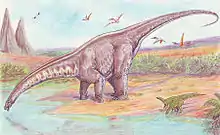 Apatosaurus .jpg.webp) Diplodocus  Mamenchisaurus | ||||
| ||||
†Thalattosuchians
| Thalattosuchians of the Tithonian | ||||
|---|---|---|---|---|
| Taxa | Presence | Location | Description | Images |
|
Germany |
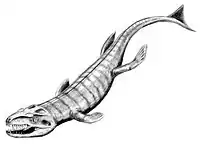 Dakosaurus, a marine crocodylomorph.  Cricosaurus, a marine crocodylomorph. | ||
|
A large genus of metriorhynchid, that was a high order predator which fed on other marine reptiles
| |||
|
|
A relatively small metriorhynchid genus. No known species of Geosaurus attained lengths in excess of 3 meters (9.8 feet). There were multiple Geosaurus species alive during the Tithonian.
| ||
|
An opportunistic carnivore that fed on fish, belemnites and other marine animals and possible carrion. | |||
|
Mörnsheim Formation, Solnhofen, Bavaria, Germany | A piscivorous rhacheosaurine | ||
†Belemnites
| Belemnites of the Tithonian | ||||
|---|---|---|---|---|
| Taxa | Presence | Location | Description | Images |
 Small belemnite fossils | ||||
References
Notes
- See for a detailed version of the geologic timescale Gradstein et al. (2004)
- Gradstein, F.M.; Ogg, J.G.; Schmitz, M.D.; Ogg, G.M. (editors) (2012). The Geologic Timescale 2012. Elsevier. p. 746. ISBN 978-0-44-459390-0.CS1 maint: uses authors parameter (link)
- Mateus, Octávio; Hendrickx, Christophe (5 March 2014). "Torvosaurus gurneyi n. sp., the Largest Terrestrial Predator from Europe, and a Proposed Terminology of the Maxilla Anatomy in Nonavian Theropods". PLOS ONE. 9 (3): e88905. doi:10.1371/journal.pone.0088905. ISSN 1932-6203. PMC 3943790. PMID 24598585.
- Molina Pérez & Larramendi (2016). Récords y curiosidades de los dinosaurios Terópodos y otros dinosauromorfos. Barcelona, Spain: Larousse. p. 261. ISBN 9780565094973.
Literature
- Gradstein, F.M.; Ogg, J.G. & Smith, A.G.; (2004): A Geologic Time Scale 2004, Cambridge University Press.
- Oppel, C.A.; 1865: Die Tithonische Etage, Zeitschrift der Deutschen Geologischen Gesellschaft, 1865: pp 535–558. (in German)
External links
- GeoWhen Database - Tithonian
- Jurassic-Cretaceous timescale, at the website of the subcommission for stratigraphic information of the ICS
- Stratigraphic chart of the Upper Jurassic, at the website of Norges Network of offshore records of geology and stratigraphy